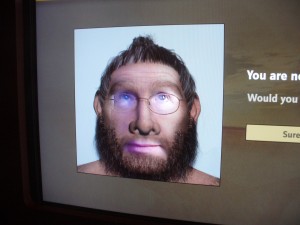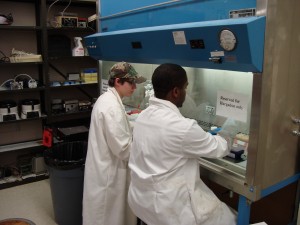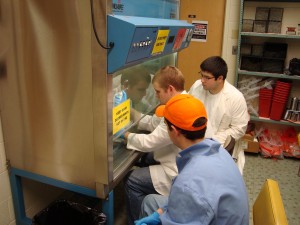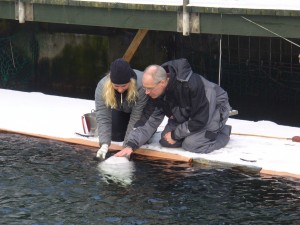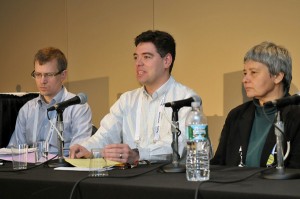Dr. Bill Shear has been appointed to the advisory board of the Journal of Cave and Karst Studies, the scientific journal of the American Speleological Society. JCKS publishes research articles on geological, hydrological, biological and engineering aspects of caves and karst terrain. Karst terrain occurs wherever there are extensive deposits of limestone on the surface, and is charactrerized by subterranean drainage, caves and sinkholes. Dr. Shear will be advising on publications about the animals that inhabit spaces underground, and has himself discovered and named many species throughout the world found only caves. In addition to his new duties, Dr. Shear is an Associate Editor of Zootaxa, a megajournal of systematic biology that in 2010 published over 30,000 pages and accounted for about 20% of all new taxa of animals described that year. He is also on the editorial board of the Journal of Arachnology, and frequently reviews manuscripts for many other journals, including Naturwissenschaft, Nature, Science, and American Scientist.
Author Archives: admin
Studying and teaching human evolution
On Saturday, February 19, H-SC Biology Professor Alex Werth attended a special workshop, jointly hosted by the Human Origins Program of the Smithsonian Institution’s Anthropology Department (www.humanorigins.si.edu) and the National Evolutionary Sythesis Center (NESCent, www.nescent.org), on “Overcoming Stumbling Blocks to Communicating Human Evolution.” The workshop brought together forty scientists who write about, teach, and conduct research in paleoanthropology. Included were writers from magazines (like National Geographic and Discover), newspapers (like the New York Times and USA Today), and leading journals, plus expert anthropologists who study all aspects of human evolution, from fossil skulls to DNA, and a few professional educators, most of whom were in Washington, DC for the annual meeting of the American Association for the Advancement of Science (AAAS). Professor Werth was invited to the workshop because he has published articles on teaching human evolution (see http://uncw.edu/cte/et/articles/Vol9_2/Werth.htm).
Before the workshop the group enjoyed a private guided tour of the Smithsonian’s new Hall of Human Origins. Professor Werth also got to greet Francis Collins, Director of NIH and co-discoverer of the Human Genome Project.
Whale research at the Smithsonian
On Saturday, February 19, Professor Werth of the Hampden-Sydney Biology Department visited with Dr. Nick Pyenson, an expert on fossil whales and Curator of Fossil Marine Mammals at the Smithsonian Institution’s Natural Museum of National History. They examined fossil material of several extinct whale species, including the rare fossil shown here. It is hoped that H-SC Biology students can get involved with this work.
H-SC Virology Students Making Influenza Virus!
It’s that time of the year when most people want to avoid the flu. Well not the case for H-SC Virology students!!!! This semester students in Dr. Kristian Hargadon’s Virology class are employing cutting edge molecular genetic techniques to reconstruct an influenza virus strain that first struck Puerto Rico in 1934! Viruses are quite simple in structure, consisting of a core of genetic material surrounded by a protective protein coat (and in the case of influenza, an additional lipid envelope). Because viruses are so simple, they cannot replicate on their own and instead must infect a cell before they can be copied and spread to other cells. The virus achieves this by releasing its genome into a cell and using the cell as a factory to produce more virus copies. Therefore, if one were to put an influenza genome into a cell, theoretically the cell could “build” the actual virus on its own. Because the entire genome of the 1934 Puerto Rico influenza virus has been sequenced, this is exactly what H-SC students are doing. Provided with plasmids encoding the influenza genome at the beginning of the semester, students are using an approach known as reverse genetics to construct the 1934 Puerto Rico influenza virus by forcing these plasmids into cell lines they are growing in culture. Once they are done, these students will learn and employ a number of techniques commonly used in virology laboratories to measure how much influenza virus was made! This approach for generating influenza virus has been a remarkable breakthrough in molecular virology and has enabled scientists around the world to construct recombinant influenza strains in order to understand the role that unique influenza gene products play in infection and viral pathogenicity!
Whale and Porpoise Research in Denmark
Professor Alex Werth spent a week (Jan 24-29, 2011) with fellow marine biologists at Aarhus University in Denmark (www.au.dk/en) to study whales. Dr. Werth served as an “opponent” or member of the thesis committee of Aarhus PhD student Malene Juul Simon, whose doctoral dissertation was on “Baleen whales, their foraging behavior, ecology and habitat use in an arctic habitat.” Specifically, she studied the feeding and migration of bowhead, humpback, and other whales in the waters around Greenland, where she lives. Dr. Werth had to attend her thesis defense—she passed and earned her PhD—as well as to present his own research findings in a symposium/workshop with many Scandinavian whale researchers. After the thesis defense Dr. Simon’s family hosted a reception with tasty Danish and Greenlandic food, including musk ox and reindeer along with many kinds of fish.
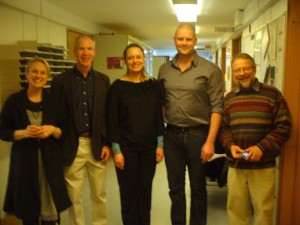
Dr. Werth also spent time with his colleague (and Simon’s graduate adviser) Dr. Peter Teglberg Madsen at the Fjord & Baelt marine research facility in Kerteminde, Denmark. With Polish PhD student Danuta Wisniewska and other graduate students they are studying feeding in harbor porpoises (Phocoena phocoena) and harbor seals (Phoca vitulina). The goal is to see how they use suction, generated by rapid depression and retraction of the tongue, to suck in water and ingest fish. This is investigated using digital tags (temporarily affixed by suction cups to the animals) which include hydrophones, accelerometers, and other sensors. High speed cameras show what the animals are doing at the same time that the tags record digital data about the animals’ movements, sounds, and muscular contractions. The harbor porpoises had to be trained to accept a small sensor on their throats along with the main tag on their backs, so Professor Werth worked with the trainers to get the animals to roll over and be tagged. This work will continue, and he hopes to return when Denmark is not as cold and snowy!
H-SC joins Howard Hughes Medical Institute (HHMI) Education Alliance
Hampden-Sydney has joined a select national group of 60 colleges and universities in the Science Education Alliance (SEA) of the Howard Hughes Medical Institute (HHMI), a leading organization in the funding of biomedical research. The SEA brings together students and faculty from member institutions in a year-long laboratory course in understanding the genetics of bacteriophage, or viruses that infect bacteria. Starting in the 2011-12 academic year, H-SC students will take part in isolating and characterizing bacteriophage from the environment, sequencing and analyzing one of the isolated genomes, and sharing results with not just other SEA members but the scientific community at large via GenBank, the depository for genetic information maintained by the National Institutes of Health (NIH).
In being accepted as an Associate Member of the SEA, Hampden-Sydney joins fellow liberal arts colleges like Gettysburg College and Smith College, fellow Virginia institutions including James Madison and William and Mary, and large research intensive institutions including Brown and Ohio State in a large national experiment whose goal is the improvement of how science is taught in the nation’s colleges and universities.
Professor Werth presents research findings at annual SICB conference
Professor Alex Werth attended the annual meeting of the Society for Integrative and Comparative Biology (SICB), which was held this January (3-7) in Salt Lake City, Utah. He presented results of his research on the baleen filtering mechanism of large whales, giving a poster entitled “Flow-dependent porosity of baleen.” The meeting offered a great chance for Prof. Werth to catch up with old friends (including a former grad school mate now teaching at JMU) make some new research contacts, and spread the word about H-SC.
Jonathan Park ’12 presents summer research at international meeting
Jonathan Park ’12 recently presented his summer research project at the annual meeting of the American Society for Cell Biology (ASCB), a gathering in Philadelphia, PA of thousands of molecular and cell biologists from around the world. Jonathan’s work, which examined how two proteins found at the edge of the nucleus in budding yeast called Brr6 and Brl1 may help to regulate cell division, was presented at two separate poster sessions, one specifically for undergraduates and one at a general session of the meeting.
Jonathan’s research advisor, Professor Mike Wolyniak, also served on a career panel at the meeting that offered advice to graduate students and postdoctoral associates on how to prepare for academic careers at different types of colleges and universities.
Jonathan’s trip to Philadelphia was supported by travel awards from the Council on Undergraduate Research (CUR) and the ASCB and spawned several interesting conversations with scientists from a variety of research groups that will hopefully lead to new research directions and projects at H-SC.
Dr. Kristian Hargadon, Osric Forrest ’12 Present Research at American Society for Microbiology State Meeting
On November 5, 2010, Assistant Professor of Biology Dr. Kristian Hargadon ’01 and junior biology major Osric Forrest ’12 presented their recent collaborative research at Lynchburg College at the VA Branch State Meeting of the American Society for Microbiology. Dr. Hargadon delivered an oral presentation, and Osric Forrest presented a poster, on their work evaluating the influence of tumor cells on the activation of dendritic cells, a cell type critical for functional immune responses. Dr. Hargadon and Mr. Forrest’s research has established that a dendritic cell line known as DC2.4 serves as an effective in vitro model for studying dendritic cell activation. Recent data has also shown that melanoma-derived factors can suppress the activation of these dendritic cells, suggesting a possible link between tumor immunosuppression and tumor outgrowth. Dr. Hargadon is currently collaborating with Mr. Forrest and other H-SC students to continue this line of research in order to better understand the immunosuppressive effect of tumors on dendritic cells and the mechanism by which this immunosuppression occurs. These findings may offer insights into novel immunotherapeutic strategies designed to improve anti-tumor immune responses.
Dr. Perry Lange, VP of LifeNet Health, Gives Biology Department Seminar
Recently, the H-SC Biology Department had the pleasure of welcoming Dr. Perry Lange, Vice President of LifeNet Health, to Gilmer Hall to give a seminar on human tissue transplantation. Dr. Lange gave an enthusiastic, energetic talk about many of the cutting-edge areas in this field and the many services provided by LifeNet Health, one of the nation’s leading organ and tissue transplant organizations. Dr. Lange’s presentation was very much hands-on for the audience, as he brought a number of items for show-and-tell that were passed among the students and faculty, including an achilles tendon, heart valve, and lung tissue. Dr. Lange currently heads the company’s Cardiovascular Services division, but he has also served in senior management positions for Tissue Processing, Client Development, Sales & Marketing, Professional Services, and Sports Medicine. This seminar was a wonderful opportunity for H-SC’s biology students to learn not only about tissue transplantation but also the variety of potential scientific careers available even within a single company!

